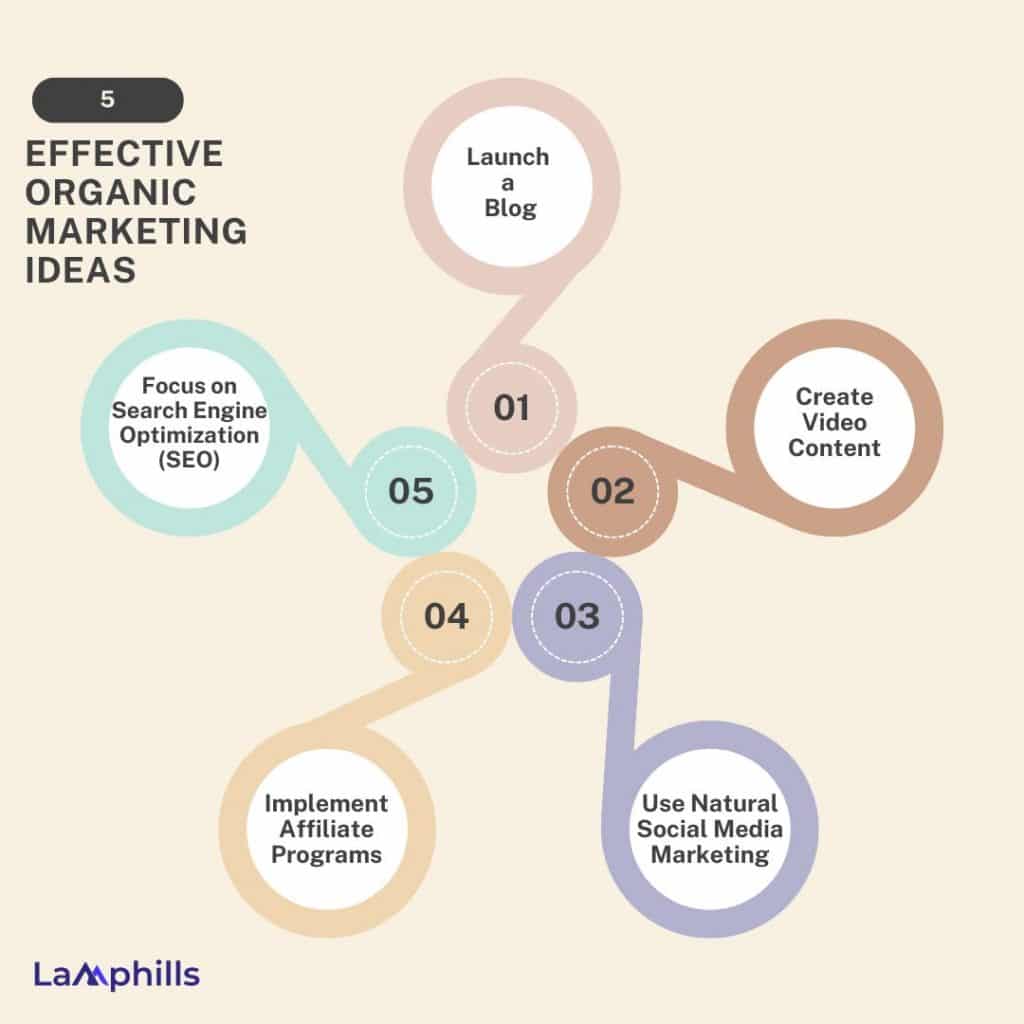I helped a friend, Sarah, who ran a small handmade soap business a while back. She was frustrated because she didn’t have the budget for paid ads and wasn’t sure how to grow her business. She asked me about organic marketing, and if it can make a difference. After deliberating on that, we decided to focus on sharing her story. Sarah started posting about how she made each soap bar, the natural ingredients she used, and why she started her business. She also encouraged her customers to share their own experiences using her products.
At first, it was slow. But then, people started to notice. Her posts began getting more likes, comments, and shares. Customers loved seeing the behind-the-scenes process and felt connected to her brand. Over time, Sarah’s following grew, and her sales followed suit.
If Sarah’s story piqued your interest, you’re in the right place. In this article, I’ll explain what is organic marketing, and why it’s important for businesses like hers, and share practical ideas that you can use too. By the end, you’ll not only understand what organic marketing is but also feel ready to apply these strategies to your own business.
Key Points
- Organic marketing thrives on content. Whether it’s a blog post, a social media update, or an email, the key is to create something that resonates with your audience.
- Paid marketing involves a direct financial cost. You pay for ads, whether through Google, Facebook, or other platforms.
- Understanding the differences between paid marketing and organic marketing is crucial for building an effective marketing strategy.
- Organic marketing ideas are strategies that don’t rely on paid advertising. Instead, they focus on attracting and engaging customers naturally.
Organic Marketing
Organic marketing is the process of attracting customers naturally through content that isn’t paid for, like blog posts, social media updates, and search engine optimization (SEO). It’s all about creating valuable, relevant content that connects with your audience over time, and building trust without spending money on ads.
Additionally, organic marketing takes patience. It’s like planting seeds and waiting for them to grow. You won’t see immediate results like with paid ads, but the long-term benefits are worth it. When I first started using organic marketing, I focused heavily on SEO. I optimized my content with relevant keywords, which gradually increased traffic. However, organic marketing isn’t just about SEO. Social media platforms like Instagram and LinkedIn also play a huge role. Sharing consistent, engaging posts helps in building a loyal following.
One suggestion I have is to use tools like Google Analytics and SEMrush to track your progress. They help you understand which content resonates most with your audience. This insight can refine your organic marketing strategy, making it more effective.
If you’re willing to invest your time and effort then organic marketing is a powerful tool to use. It’s not about quick wins but about creating lasting connections with your audience. By focusing on organic marketing, you’re building a brand that stands out because of its value, not just because of a big ad budget.
How Does Organic Marketing Work?
Organic marketing is about building your brand’s presence naturally, without relying on paid ads. It works by consistently creating and sharing content that adds value to your audience. The goal is to make your brand recognizable so that when people need a service or product you offer, they choose you because they trust what you represent.
From my experience, organic marketing thrives on content. Whether it’s a blog post, a social media update, or an email, the key is to create something that resonates with your audience. For example, I’ve seen how a well-written blog post can drive traffic to a website for months simply because it answers a question people are searching for. The beauty of this marketing is that once you’ve created this content, it keeps working for you without extra cost.
SEO is another essential tool in organic marketing. It helps your content get found by the right people. I’ve worked on optimizing blog posts with SEO, and it’s amazing to see how a few tweaks can make a big difference in search engine rankings. SEO ensures that your content is visible, which is crucial for organic marketing to work effectively.
Email marketing is another powerful aspect of organic marketing. Platforms like SendPulse help manage campaigns, and they are a great way to nurture leads. By sending targeted, relevant content directly to people’s inboxes, you keep your brand top-of-mind without being pushy. It’s about building a relationship, not just making a sale.
In essence, organic marketing is about putting in the work upfront to create valuable content that naturally attracts and retains customers. It’s a long-term strategy, but one that pays off as your brand becomes the trusted choice for your audience
Benefits of Organic Marketing
Organic marketing is about growing your brand without paying for ads. It’s all about connecting with your audience through quality content, consistent engagement, and authentic interactions. Here are the key benefits of organic marketing:
- Cost-Effective: Organic marketing doesn’t require a big budget. You don’t need to pay for ads. Instead, you focus on content creation and engagement, which can be done with time and effort. From my experience, using tools like SEO and social media can drive traffic without spending a dime on ads.
- Builds Trust: Organic marketing builds a genuine connection with your audience. When you offer valuable content, people see you as an authority in your field. Over time, this trust turns into loyalty. I’ve seen how sharing helpful content on platforms like LinkedIn boosts credibility and attracts a dedicated following.
- Long-Term Results: Organic marketing isn’t about quick wins; it’s about steady growth. Once your content gains traction, it continues to bring in traffic and leads. This is different from paid ads, which stop as soon as you stop paying. My blog posts, optimized for SEO, still bring in traffic years after they were published.
- Higher Engagement: Organic marketing encourages real interactions. Your audience isn’t just scrolling past an ad; they’re actively engaging with your content because they’re genuinely interested. This engagement is more meaningful and leads to stronger relationships. I’ve noticed that posts with genuine, valuable content get more likes, shares, and comments, making them more visible and effective.
- Adaptability: Organic marketing is flexible. You can quickly adjust your strategy based on what’s working. If a particular post or topic resonates with your audience, you can create more content like it without worrying about budget constraints. Using tools like Google Analytics or social media insights can help you tweak your approach for better results.
A social media content calendar template helps you plan, organize, and schedule your social media posts in advance. Here’s a simple template you can use
Social Media Organic Marketing
Organic social media marketing promotes your brand or business on social media platforms without paying for advertisements. It involves creating and sharing content that naturally engages your audience, growing your followers, and building relationships over time.
Furthermore, organic social media marketing focuses on building genuine connections with your audience. You’re not paying for clicks or views but instead relying on the quality of your content to attract attention. This type of marketing requires consistency. Whether it’s posting updates, sharing stories, or engaging with followers, the goal is to increase visibility and trust through meaningful interactions. Organic social media marketing can take time to see results, but it’s about creating long-lasting relationships. You build a community that supports your brand by staying active, responding to comments, and sharing valuable content.
Also See: 9 Social Media Marketing Skills in Demand for Managers in 2024
TikTok Organic Marketing
The term “TikTok Organic Marketing” is about using TikTok’s platform to grow your brand without paying for ads. It’s all about leveraging the power of the platform’s algorithm, culture, and community to reach a wide audience naturally. When you’re doing TikTok organic marketing, you’re creating and sharing content that resonates with your audience, jumping on trends at the right moment, and engaging directly with your followers. The focus is on creativity and authenticity, which are key to standing out on TikTok.
One of the main strengths of TikTok organic marketing is that it allows you to test different strategies and see what works best for your brand. By creating original content that aligns with the platform’s trends and actively engaging with your audience, you can build a loyal community around your brand. TikTok organic marketing also involves integrating user-generated content, responding to comments, and joining conversations that matter to your followers. The goal is to blend in with the TikTok experience, providing value to users while maintaining your brand identity. This approach not only helps in expanding your reach but also fosters a deeper connection with your audience, leading to long-term success on the platform.
TikTok Organic Marketing Strategies
Organic marketing strategies are your best bet. TikTok’s unique platform offers endless opportunities to connect with your audience without relying on paid ads. I’ll break down vital essential strategies that can help you elevate your brand’s presence on TikTok.
#1. Setting Up Your TikTok Business Account
Creating your TikTok business account is the first step to leveraging organic marketing strategies. Start by signing up, then switch to a business account in the settings. This setup is crucial for tracking analytics and accessing features designed for brands. A well-optimized profile is your brand’s first impression on TikTok. Your bio, profile picture, and link should clearly represent your brand, making it easier for potential followers to understand who you are.
#2. Developing a TikTok Marketing Plan
Crafting a marketing plan on TikTok involves understanding your goals, target audience, and the type of content that will resonate with them. A clear strategy outlines what you want to achieve—whether it’s increasing brand visibility, engaging with your community, or driving traffic to your website. Define your brand voice, plan content types, and establish a posting schedule. Consistency and alignment with your brand’s message are key to successful TikTok organic marketing strategies.
#3. Essential Content Creation Tips
Content creation is at the heart of TikTok’s organic marketing strategies. Focus on producing content that aligns with your brand’s values and speaks to your target audience. High-quality videos are a must, but authenticity matters more. Use TikTok’s tools like filters, effects, and soundtracks to enhance your content. Aim for creativity and relevance, which are essential to capturing attention and boosting your brand’s visibility.
#4. Crafting Content That Resonates
Developing content that resonates with your audience is vital for successful TikTok organic marketing strategies. Understand what your audience cares about and tailor your content to those interests. Whether it’s educational, entertaining, or inspirational, the content should align with your brand’s message. Content that connects on an emotional level tends to perform better, leading to higher engagement and increased brand visibility.
#5. Leveraging TikTok Trends and Hashtags
Utilizing TikTok trends and hashtags effectively can amplify your TikTok organic marketing strategies. Keeping an eye on trending content and participating in viral challenges can boost your brand’s visibility. Use relevant hashtags to reach a wider audience, but make sure they are specific to your niche. Trends and hashtags are powerful tools for gaining traction and staying relevant on TikTok.
#6. Mastering TikTok Content Types and Formats
Understanding different content types and formats on TikTok is essential for maximizing your marketing strategies. TikTok offers a variety of content formats like short clips, challenges, duets, and live streams. Each format has its strengths, and experimenting with them can help you discover what works best for your brand. Diverse content keeps your audience engaged and helps boost your brand’s visibility on the platform.
#7. Building and Engaging with Your TikTok Community
Building and engaging with your community is a core aspect of TikTok’s organic marketing strategies. Responding to comments, engaging with followers’ content, and creating a dialogue with your audience build loyalty and increase brand visibility. A strong, engaged community can amplify your brand’s message, helping you reach new followers organically.
#8. Using TikTok’s Features to Enhance Engagement
Utilizing TikTok’s unique features is key to effective organic marketing strategies on the platform. Features like duets, stitches, and live streams allow you to interact directly with your audience. They create opportunities for more personalized connections, which can enhance your brand’s visibility. Regularly exploring and leveraging these features can make your content more dynamic and engaging.
Here is an infographic on organic marketing ideas, which is an engaging way to present strategies that businesses can use to boost their visibility without paid advertising.

Organic Marketing Ideas
Organic marketing ideas are strategies that don’t rely on paid advertising. Instead, they focus on attracting and engaging customers naturally. These ideas work by creating valuable content that people find helpful or entertaining, which leads to more visibility and trust without direct costs. Here are some effective organic marketing ideas:
#1. Launch a Blog
Starting a blog is one of the simplest organic marketing ideas. It allows you to share knowledge, provide value to your audience, and establish yourself as an authority in your industry. Regularly updating your blog with relevant content drives organic traffic to your website and improves your search engine rankings. This organic marketing approach builds trust and keeps your audience coming back for more.
#2. Create Video Content
Producing video content is another powerful organic marketing idea. Videos can capture attention quickly, making complex topics easier to understand. Whether you’re sharing tutorials, customer testimonials, or behind-the-scenes looks, video content engages your audience and boosts your organic reach. This type of organic marketing helps you connect with your audience on a deeper level.
#3. Use Natural Social Media Marketing
Organic social media marketing focuses on building relationships with your audience without paid ads. By consistently posting engaging content, interacting with followers, and using relevant hashtags, you can grow your social media presence naturally. This organic marketing strategy enhances brand awareness and fosters a loyal community around your brand.
#4. Implement Affiliate Programs
Creating an affiliate program is a smart organic marketing idea. It encourages others to promote your products or services in exchange for a commission. This type of organic marketing leverages the power of word-of-mouth and can lead to increased sales without the need for paid advertising. Affiliates share your brand with their networks, expanding your reach organically.
#5. Focus on Search Engine Optimization (SEO)
Optimizing your website for search engines is a crucial organic marketing idea. SEO involves using the right keywords, creating high-quality content, and ensuring your website is user-friendly. This organic marketing strategy improves your site’s visibility in search engine results, driving more traffic and potential customers to your site without paying for ads. It’s a long-term approach that pays off by keeping your brand visible and accessible online.
How Do You Drive Organic Marketing?
Driving organic marketing involves creating content that naturally attracts your audience without paid promotions. From my experience, the key is consistency and value. You need to post regularly and ensure your content provides real benefits. Think of blogs, social media posts, or videos that solve problems or entertain.
Next, focus on SEO. Use keywords that people search for and optimize your website to rank higher on search engines. This helps your content get found.
Finally, engage with your audience. Respond to comments, ask questions, and build a community. The more you interact, the more people will share your content, driving organic growth.
What Are the Differences Between Paid Marketing and Organic Marketing?
Understanding the differences between paid marketing and organic marketing is crucial for building an effective marketing strategy. Each approach has its unique benefits and challenges, and knowing how they differ can help you decide where to allocate your resources. Let’s break down these differences to help you understand when and how to use each one.
#1. Cost
Paid marketing involves a direct financial cost. You pay for ads, whether through Google, Facebook, or other platforms, and these costs can vary depending on your targeting options and competition. You might be charged per click (PPC), per impression (CPM), or per acquisition (CPA). While you can control your budget, it’s essential to remember that paid campaigns need consistent investment to maintain visibility.
On the other hand, organic marketing doesn’t require direct payment for exposure. Instead, the “cost” comes in the form of time, effort, and resources spent on creating quality content, optimizing your website, and engaging with your audience. Though you’re not paying for clicks or impressions, the investment is still significant in terms of the time it takes to produce results.
#2. Speed of Results
Paid marketing is all about speed. The moment your ad goes live, it can start driving traffic, generating leads, or boosting sales. It’s ideal for businesses looking to achieve quick wins, such as during a product launch or a limited-time promotion. However, the impact lasts only as long as the money flows.
Organic marketing, in contrast, is a marathon, not a sprint. Building a presence through content marketing, SEO, and social media takes time. You won’t see immediate results, but as your content gains traction, your visibility and authority grow steadily. This slow and steady approach pays off in the long run, with more sustainable traffic and engagement.
#3. Control
With paid marketing, you have a high level of control over your campaigns. You can target specific demographics, choose when and where your ads appear, and even adjust your campaign on the fly based on performance data. This precision allows you to tailor your messaging to different audience segments and optimize for the best results.
Organic marketing, however, offers less direct control. Your content’s reach depends largely on algorithms and organic engagement. While you can optimize your content for search engines and tailor it to your audience’s preferences, you don’t have the same immediate influence over who sees your content or when. Success in organic marketing often requires patience and consistency.
#4. Audience Engagement
Paid marketing can quickly put your brand in front of a large audience, but it doesn’t always lead to deep engagement. Since people know they are being marketed to, they may not interact with your ads as authentically as they would with organic content. Paid ads can sometimes be viewed as intrusive, which might lead to lower engagement rates.
Organic marketing, by contrast, tends to foster more meaningful interactions. When people find your content naturally—whether through a Google search, a social media recommendation, or word-of-mouth—they are more likely to engage because they sought it out. This leads to higher levels of trust and loyalty, as your audience feels a genuine connection to your brand.
#5. Sustainability
Paid marketing is often used for short-term goals. Whether you’re launching a new product or running a limited-time promotion, paid campaigns are great for generating quick results. However, once you stop paying for ads, the traffic and leads typically drop off, making it less sustainable for ongoing growth.
Organic marketing shines in long-term sustainability. The effort you put into creating quality content and optimizing it for search engines continues to pay dividends over time. Your content can keep attracting visitors and leads long after it’s published, providing a steady stream of organic traffic without the need for constant investment.
#6. Content Creation
Paid marketing often revolves around creating ad-specific content designed to convert quickly. This might include attention-grabbing headlines, strong calls to action, and visually appealing designs. The goal is to make an immediate impact, so the content is usually concise and focused on driving a specific action, like clicking a link or making a purchase.
Organic marketing requires a different approach. The content is typically longer, more informative, and designed to provide value to the reader. Whether it’s blog posts, videos, or social media updates, the content aims to engage and educate the audience over time. It’s not just about making a quick sale; it’s about building a relationship with your audience through consistent, valuable content.
#7. Dependence on Platforms
Paid marketing is highly dependent on the platforms where you advertise. Changes in platform algorithms, ad policies, or costs can significantly impact your campaigns. For example, if Facebook suddenly increases ad prices or changes how they target ads, your campaign’s effectiveness could be affected.
Organic marketing, while still influenced by platforms, is less dependent on them. By focusing on SEO, quality content, and genuine audience engagement, you can build a presence that isn’t as vulnerable to platform changes. However, it still requires adapting to changes in search engine algorithms or social media trends, but the impact is often less direct compared to paid marketing.
Is Organic Marketing Worth It?
Yes, organic marketing is worth it. From experience, organic marketing drives long-term growth without the constant cost of ads. Unlike paid marketing, organic strategies like content creation and SEO build trust and credibility. It takes time and effort, but the results are lasting and bring in loyal customers.
How Do You Master Organic Marketing?
To master organic marketing, start by knowing your audience. Understand what they need and how they think. Then, create content that speaks directly to them. Make sure it’s valuable, consistent, and authentic. Engage with your audience regularly, responding to their comments and messages. Use SEO to help your content get found. Collaborate with influencers in your niche. Build relationships with other brands. Lastly, track your results and adjust your strategies based on what works.
Related Articles
Data Privacy in Marketing: Best Practices and Key Considerations For Marketers
How I Create Effective Content Pillars for Marketing Strategy: A Guide for Marketers
Expert Tips for Effective Engagement Marketing: Approaches to Boost Customer Interaction





